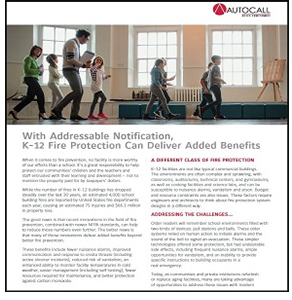January 9, 2019
 When it comes to fire prevention, no facility is more worthy of our efforts than a school. It’s a great responsibility to help protect our communities’ children and the teachers and staff entrusted with their learning and development – not to mention the property paid for by taxpayers’ dollars.
When it comes to fire prevention, no facility is more worthy of our efforts than a school. It’s a great responsibility to help protect our communities’ children and the teachers and staff entrusted with their learning and development – not to mention the property paid for by taxpayers’ dollars.
While the number of fires in K-12 buildings has dropped steadily over the last 30 years, an estimated 4,000 school building fires are reported by United States fire departments each year, causing an estimated 75 injuries and $66.1 million in property loss.
The good news is that recent innovations in the field of fire prevention, combined with newer NFPA standards, can help to reduce those numbers even further. The better news is that many of those innovations deliver added benefits beyond better fire prevention.
These benefits include fewer nuisance alarms, improved communication and response to onsite threats (including active shooter incidents), reduced risk of vandalism, an enhanced ability to monitor facility temperatures in cold weather, easier management (including self-testing), fewer resources required for maintenance, and better protection against carbon monoxide.
A DIFFERENT CLASS OF FIRE PROTECTION
K-12 facilities are not like typical commercial buildings. The environments are often complex and sprawling, with classrooms, auditoriums, technical centers, and gymnasiums, as well as cooking facilities and science labs, and can be susceptible to nuisance alarms, vandalism and arson. Budget and resource constraints are also issues. These factors require engineers and architects to think about fire protection system designs in a different way.
ADDRESSING THE CHALLENGES…
Older readers will remember school environments filled with two kinds of devices: pull stations and bells. These older systems relied on human action to initiate alarms and the sound of the bell to signal an evacuation. These simpler technologies offered some protection, but had undesirable side effects, including frequent nuisance alarms, ample opportunities for vandalism, and an inability to provide specific instructions to building occupants in a real emergency.
Today, as communities and private institutions refurbish or replace aging facilities, many are taking advantage of opportunities to address these issues with modern solutions.
